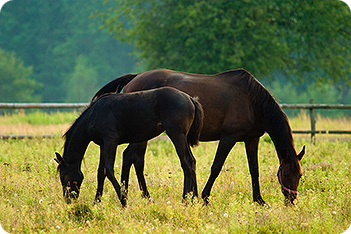
Yearly Care Of Horse Pasture
From: Horse Care |Pasture And Grazing
See also: Poisonous Plants | Fences |Field Equipment | Worming

Yearly Horse Grazing Pasture Care
Good field management throughout the year will help your fields to remain in good condition. Harrowing, fertilizing, re seeding, resting, rotation, rolling, the amount of horses in each field. fence care, field shelter care, gateways, water troughs and drainage are all elements of maintaining good healthy fields.
- Field Rotation
By having several fields at your disposal will allow you to be able 'rest' different fields to allow them to be treated and recover in plenty of time before horses are put back to grazing on them. - Number Of Horses Per Acre
As a rough guide allow 2 acres for one horse and then an additional acre for any other horses that you wish to add. Obviously the more room they have the more food there is to potentially go around and the less stressful the field becomes. - Drainage
- Drainage Ditches
Drainage ditches around the perimeter of your field will need to be cleared out in order for them to remain in good working order. - Underground Drains
Adding underground drains to your fields will help to improve your fields drainage. The underground drains should lead to either ditches or a stream. If your drains lead to a stream then you must take care when you fertilize to ensure you do not pollute the stream with the contents.
- Drainage Ditches
- Water
The water trough will need to be checked on a daily basis to ensure that there is a constant supply of fresh water available at all times. If you are relying on a stream then you will still need to check that the horse can easily get access to it and that there is a plentiful supply available. The water trough will need to be completely emptied and scrubbed clean twice a year so that the trough remains with a fresh supply of water. - Field Resting
Allowing your fields time to recover is essential so that you can improve the quality of the grasses and conditions within the field. Resting the field will also allow you to make any alterations to the fences, drainage, shelters or water supply as well as assessing the soil acidity so that you know what fertilizer your fields will need to be treated with, if possible rest fields for a year to allow them to sufficiently recover. - Soil pH Test
This can be assessed by taking a sample of soil and sending it to a lab for analysis. The laboratory will be able to inform you what your soil is deficient in and recommend a suitable fertilizer. - Fertilizing
Once you know what your field may be deficient in then you can top it up with the correct type and amount of fertilizer. Fields for horses need the correct balance of Nitrogen (N), Phosphorous (P) and Potassium (K). - Harrowing
A harrow is a piece of agricultural equipment that has many spikes on it, a harrow is dragged along the ground with the purpose being to to pull up any dead grasses and spread out any droppings that may have been left as well as to aerate and allow moisture into the ground.
- Re seeding
Applying seed to your fields can help you to improve the grasses within the field and assist any areas of the field that are bare. - Rolling
Use a roller to help push the seed into the ground and also to flatten out any bumpy areas that may have been left after the winter. - Sheep
Sheep are a great way of improving your fields grazing, as they will help keep any lush areas of grass down in preparation for your horses.
Daily Care
- Skipping Out
Throughout the spring, summer and early autumn months, regular skipping out of droppings from your horses field will help to maintain a low worm count as well as reducing areas of the the field that can become horse sick and improve the general appearance of your fields. - Safety Checks
Regular checks of both your horses and fields is essential to make sure that everything is working and safe for your horses to be out in. - Fencing
You will need to check all fencing that surrounds the field that your horses are in so that any repairs to broken parts can be quickly dealt with. If you do find a broken part of the fence you will need to double check that none of the horses have been injured by it. - Gateways
Ensure that the gateway into and out of your field is easy to lock and to open and close and is therefore secure. In the winter fencing off the gateway can sometimes help to reduce the problem of the gateways becoming churned up. - Shelters
Check that your field shelter is safe from broken parts or sharp edges and that it is remaining water tight.
Seasonal Guide
- Spring
In the spring is the best time for harrowing, fertilizing, re seeding and rolling any field that was used throughout the winter or that is due for resting, this process with sufficient rest and those spring showers will assist in an excellent growth of grass. - Summer
Continue to rest fields on rotation or move horses onto fields that are ready and safe for horses to use. - Autumn
Fertilize fields that are about to begin to be rested. - Winter
Horses do most damage to the fields in the winter time so where possible have sacrifice fields, these fields will limit the extent of damage done to only one or two fields leaving you with fresh fields ready for the spring.